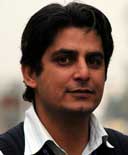Scenes from Pakistan’s 9/11 decade |
Tauseef Akhtar walks through a body scanner at the entrance gate of the Data Ganj Bakhsh Hajveri shrine in Lahore. A guard comes over to cautiously search his body for explosives. The 32-year-old Akhtar, who has eaten and slept here for the last 16 years, says he does not endorse this practice of screening devotees on the mausoleum of a saint, but he understands the need.
On July 1, 2010, three suicide bombers had killed 42 and injured 176 of the innocent devotees in Lahore's most iconic and revered religious site.
The tomb of Data Ganj Bakhsh Hajveri, a Central Asian Sufi saint who lived around 1000 AD, attracts thousands of followers daily, with Thursdays and Fridays the most crowded. Some 3,000 people were present in the complex when the terrorists struck.
"I was inside the main hall when two blasts rocked the shrine," Akhtar recalls, pointing. Body parts and debris fell on Akhtar, injuring his back and left leg, though his body has since healed.
"Sound of blasts and gory scenes in the courtyard are part of my routine nightmares," he says in a somber tone. "I wake up thinking, Why on Earth would a Muslim kill worshippers here?"
A year later, the culprits still remain unidentified. In this incident as in others like it, either "militants'" claim responsibility through an obscure spokesman, a fax, or a little known website, or the government conveniently attributes it to be Taliban's handiwork.
From the North to the South of Pakistan, most significant Sufi shrines, popular particularly among Sunni Muslims, have been targeted in a campaign that appears well organized.Asim Sahibzada, who belongs to the Chishti order of Sufi tradition, sees the reign of terror as a calculated move to deter people from this tolerant and pacifist brand of Islam and to push them to embrace the militants' way.
"The enemies of Pakistan, whether extremist militants or foreign powers, are using such tactics not only to scare people from spirituality but to deepen sectarian fissures in the society as well," he told me in a telephone interview. Sahibzada believes that proponents of such violence "find sanctuaries in parts of society having little cushion for dialogue and co-existence".
Pakistani intellectuals have for years warned about the consequences that an increasingly theocratic regime in Afghanistan would have on Pakistan, but are largely ignored by government and civil society. The Pakistani leadership, in its decades-old dream of gaining "strategic depth" in Afghanistan by supporting allied militant groups there, still backs the Taliban in Afghanistan as well as in Pakistan's semi-autonomous tribal areas along the western border. Innocent people in Pakistan, like Akhtar and others at the Hajveri shrine last July, are wounded or killed by the Taliban's ever-multiplying offshoots.
For Pakistan, a country still mired in a decades-old standoff with India over the disputed Jammu and Kashmir regions and feuding over increasingly poisonous diplomatic rows with the United States, supporting the Taliban has been considered, as military leaders put it, "a strategic compulsion."
• • • • •
Live images of jetliners crashing into the World Trade Center rattled Pakistan's establishment, controlled by sitting Chief of Army Staff and President General Pervez Musharraf. Washington blamed Taliban-controlled Kabul for sheltering the terrorists and financiers responsible for launching the attacks.
Pakistan had been the third country, after Saudi Arabia and the United Arab Emirates, to recognize the Taliban government in Afghanistan, which controlled over 90 percent of the rugged, war-torn country. Still, Musharraf quickly condemned the attacks, later agreeing to provide airfields, open air space, and share intelligence to help the U.S.








 Naveed Ahmad is an investigative journalist with special focus on diplomacy, security and energy politics. He jointly heads
Naveed Ahmad is an investigative journalist with special focus on diplomacy, security and energy politics. He jointly heads 
Post new comment